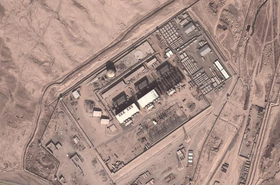The US Department of Homeland Security has awarded General Dynamics a contract to maintain one of its data centers in Mississippi.
CRSA, which General Dynamics acquired in 2018, has operated the DHS Data Center 1 since July 2008, but the site is owned by the government. A second data center is maintained and owned by Perspecta, but the contract is expected to run out this year as DHS shifts to the cloud - barring potential delays.
DC1 is located at the National Center for Critical Information Processing and Storage at the NASA Stennis Space Center in Mississippi, and public documents from 2011 state that it has "approximately 63,000 square feet of raised floor space" and the "complex consists of three large attached buildings."
Don't mention ICE
The $2.8m contract runs until the end of the year "for the purpose of providing continued operations and maintenance (O&M) support"
In a Request for Information last year, the DHS noted that six percent of its applications were run in the cloud as of December 2018, and "a total of 171 of 628 (26 percent) systems are currently either planning, in development, actively migrating, or operational in the cloud."
Under its 'EAGLE Next Generation' modernization initiative, DHS is pursuing "a hybrid, multi-cloud, federated and vendor neutral" overhaul of its $6.8bn IT portfolio.
In its 2019 RFI, the agency said that it was making "appropriate plans to reflect the expiration of the current Data Center 2 contract in June 2020. Simultaneously, we are right sizing our footprint in Data Center 1 to support optimization of that facility."
The department said that 30 percent of the applications leaving Data Center 2 may need assistance in migrating to the cloud, and that "most have indicated challenges and high risk" to leave by the target date.
In 2018, then-DHS CIO John Zangardi told the Washington Technology conference that the agency was looking for several cloud providers: "We don’t want a hundred, but this will be a hybrid strategy that will allow for multiple players."
But, with the Department of Homeland Security responsible for running Immigration and Customs Enforcement (ICE) and the Customs and Border Protection (CBP) agency, cloud contracts have proved controversial.
Throughout 2019, employees at Google, Amazon, Microsoft, and Salesforce protested against the fact that their companies work with ICE and CBP, but with little success.
A 2019 CBP request for information on cloud services said that it already used Google Cloud, Amazon Web Services, Microsoft Azure, IBM Cloud, and Oracle Cloud. It also used Salesforce and ServiceNow, as well as Quip, Zoom, Office 365, Power BI, IBM Maximo, IBM Trirega, and Presidio.
Microsoft provides cloud services for ICE to support "legacy mail, calendar, messaging and document management workloads" in a $19.4m contract.
"Like many of you, I am appalled at the abhorrent policy of separating immigrant children from their families at the southern border of the US," CEO Satya Nadella told employees after they complained about the contract. "I want to be clear: Microsoft is not working with the US government on any projects related to separating children from their families at the border."
The DHS's system for identifying people using fingerprints, irises and faces (and eventually DNA, palm prints, scars, and tattoos), along with information on 250 million people, is currently being shifted to Amazon Web Services.
Perspecta - a military contractor formed out of Vencore, DXC, and Keypoint - operates DHS' second data center. It has also partnered with AWS to help prepare for when the contract expires.
In a publicly available Perspecta document that appears to have been written for DHS, it says it will deliver AWS Cloud Migration Readiness Assessments and Migration Readiness and Planning (MRP) services for DHS Data Center 2. "Our team will review and assess your migration goals and your current state of readiness for a specific scope of migrations to AWS.
"The outcome will be a data-driven readiness assessment and proposed outline of work to be used in your small or large-scale migration to AWS."





